This was published 3 years ago
New Zealand travel bubble: Five things to know about NZ before you go
By Anthony Dennis and Sue Williams
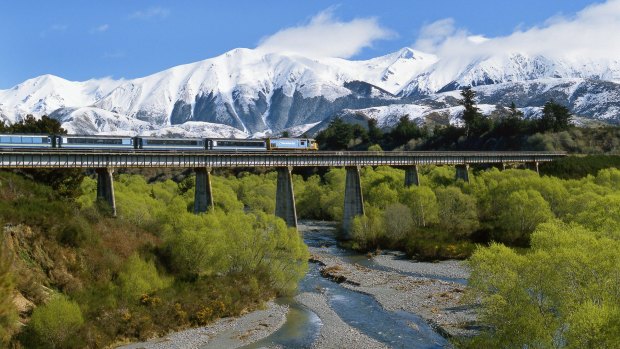
The TranzAlpine, a 10-hour round trip, runs from Christchurch on the east coast of the South Island to Greytown on the west.Credit: Alamy
Listen up, all of you at the back of the classroom. We've always loved visiting our cuzzies across the dutch (sorry, ditch). For a lot of us it had almost become Hobbit forming (we're even starting to talk like them, what with all of this inflationary bubble business).
But we've been worlds apart for more than a year now, thanks to you-know-what, and much has happened in that time. There's a whole heap of new attractions, hotels, restaurants, places to discover and old favourites with which to reconnect.
Now that we're finally able to return to our if not nearest, certainly dearest, neighbour, it's time to brush up on those old Kiwi playbooks, re-learn what we've been missing, check out what's new and polish up our manners. What could possibly go wrong, aside from a sudden snap lockdown or two?
So sit up straight. Pay attention. Dust off your jandals for the ultimate Kiwi tiki tour as we guide you through this special Traveller refresher course for the have-beens and never beens (shame on you). Let's go, bro.
LESSON ONE: THE CITIES
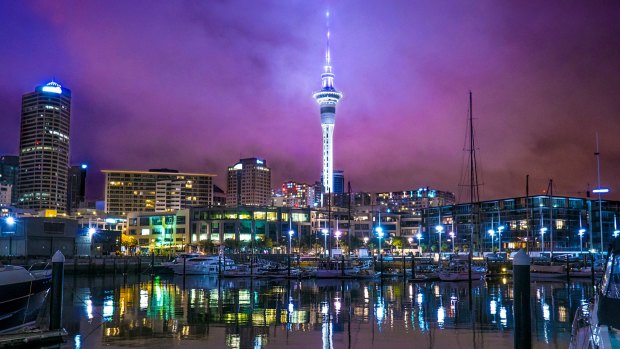
Writer and broadcaster Clive James once told Andrew Denton in an interview that he'd just returned from a five-cities promotional book tour of New Zealand. Denton mischievously replied that he didn't realise that it had that many cities. There are actually 16 of them – 11 on the North Island and five on the South Island. Most are small and by far the biggest city, Auckland (
Basking in the glory of yet another America's Cup triumph last month, it's set on a turquoise harbour and boasts lovely beaches ranging from the quiet beauty of Mission Beach to the surf beach of Orewa in the north and then the wild western coast warrior wipeouts at Piha.
Visit the volcanoes, around 55 of them, with splendid views from the tops of Mount Eden and Rangitoto, while a ferry day trip to Waiheke Island, New Zealand's own wine island, is a must, with 30-odd vineyards and smart accommodation. Beyond the natural attractions you'll find outstanding restaurants, amazing cafes and excellent, often quirky shopping including artisan jewellery, clothing and shoe-makers.
Next stop Wellington (wellingtonNZ.com), New Zealand's compact capital that is even smaller than Canberra. Many consider this city the epicentre of Kiwi fine food. For fans of The Lord of The Rings, the supposedly windiest city on the planet now offers a behind-the-scenes look at Oscar-winning Peter Jackson's Weta Workshop (wetanz.com) that created so much of the on-screen magic, and a tour of the movies' locations. But even before the advent of Peter Jackson, the city was quirky, cute, and cool in a decidedly retro way.
Christchurch (christchurchnz.com) is the South Island's major city with a tragic recent past but a huge optimism about its future. Devastated by a series of earthquakes from 2010 to 2012, its crumbled Anglican Cathedral Christ Church still bears the scars, though check out the supposedly temporary but definitely remarkable Cardboard Cathedral (cardboardcathedral.org.nz) designed by the Pritzker Architecture Prize-winning Japanese-Korean architect, Shigeru Ban. The city's undergoing a massive though slow post-quake urban regeneration, with cutting-edge new buildings, alongside the heritage precincts, a thriving arts scene, and well-manicured gardens and parks.
Further south, smaller and some may say more dour, Dunedin (dunedinnz.com) is set in a former volcanic crater on the east coast of the South Island. It is home to the world's rarest penguin (the yellow-eyed species), the world's rarest sea lion (the New Zealand version), New Zealand fur seals and little blue penguins as well as Baldwin Street, the steepest street in the world.
TRAVELLER CHEAT SHEET
No longer a Sydney wannabe, there's a new Kiwi-style sophistication to be found in Auckland. It has new cool restaurants, cafes, bars and shop-filled CBD laneway culture off the main drag, Queen Street, and down towards the waterfront.
LESSON TWO: THE TOWNS
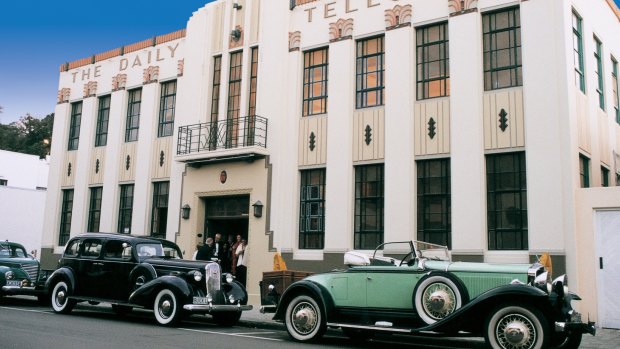
The slightly less-visited Wanaka, 70 kilometres north-east of Queenstown, is at the entrance to the world-heritage Mount Aspiring National Park (doc.govt.nz), with two lakes, glaciers and waterfalls, as seen in The Lord of the Rings trilogy. It has fishing, kayaking, cruising cafes, restaurants and Cinema Paradiso – where you can sit in a Morris Minor to watch a movie and have snacks. And if that's not vintage enough for you, it's also the only cinema to still have an intermission in Australasia. Tres Kiwi.
Akaroa (visitakaroa.com), 400 kilometres further north, is a curious though compelling mix of French and English heritage, stemming from its colonial history. This popular stop for cruises also offers the chance to spot Hector dolphins. The tricolour and the Union Jack both jostle for space here, as the town's painted in red, white and blue with some great little stores, cafes and restaurants.
Taupo (lovetaupo.com) in the middle of the North Island is a vast playground for fishing, hiking, water and snow sports and is also home to the now Ausralian-owned Huka Lodge, the pinnacle of Kiwi luxury accommodation.
Napier, on Hawke's Bay, is one of New Zealand's most fascinating towns-cum-small-cities. Destroyed by an earthquake in 1931, rebuilding began immediately and now it's one of world's the most beautifully-preserved art deco towns.
Kaikoura (kaikoura.co.nz), north of Christchurch, is a beautiful seaside town, where the mountains meet the sea. It has a similar laid-back, eco vibe to our own Byron Bay and offers plenty of whale, dolphin and seal spotting. Kaikoura is actually Maori for "eat crayfish", and there's plenty of opportunity for that here, too.
TRAVELLER CHEAT SHEET
For some beautiful small coastal and inland towns head to the sub-tropical and superb Bay of Islands (visitboi.co.nz), north of Auckland, where the Waitangi Treaty was signed by the British Crown and Maori chiefs in 1840. There are also traces of the 19th century European missionary presence in and around the charming township of Russell.
LESSON THREE: THE WONDERS
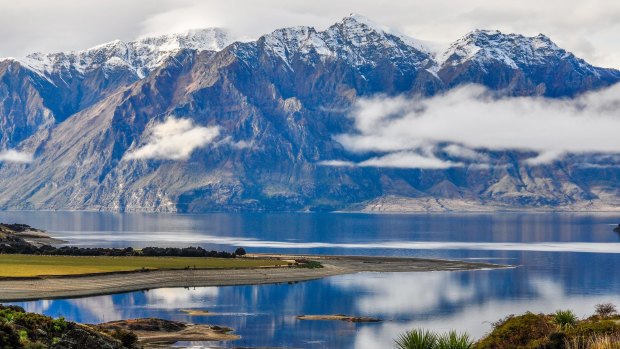
The Land of the Long White Cloud is also the land of magnificent mountain ranges, steep ravines, lush rainforests, national parks, icy glaciers, tranquil lakes, gushing waterfalls, teeming wildlife, beautiful beaches and … adrenaline-pumping adventure.
For hikers, there are some of the most dramatic walks in the world, including the Milford Track, Routeburn Track, Kepler Track, Rakiura Track, the Abel Tasman Coastal Track and the Hollyford Track (newzealand.com). For bikers, there's a huge range of cycle tracks, with the longest being the Nga Haerenga, The New Zealand Cycle Trail (nzcycletrail.com), from the top of the North Island to the bottom of the South.
There's skiing in Queenstown and Wanaka, gondolas and luge rides, scuba diving at one of the top dive sites in the world, Poor Knights Islands in the Northland region (northlandnz.com) on the far North Island, and bungee jumping, abseiling, rock-climbing and other adventure sports almost everywhere.
Don't miss the two to three-day road trip from Queenstown to Milford Sound, one of the most scenic in the world, past rainforest, snowy mountains and stunning mirror lakes. Take a break in Fiordlands National Park (fiordland.org.nz) for a hike along the way. Take a trip from Auckland to Coromandel (thecoromandel.com), the beautiful peninsula boasting Hot Water Beach where you can make your own spa bath in the sand as the warm water bubbles up from the geothermal activity beneath. On the gorgeous Cathedral Cove Walk, see magnificient cliffs and marvel at some of the best beaches in the world.
TRAVELLER CHEAT SHEET
Leave the hire car or campervan behind and catch one of the world's true great small railway journeys. The TranzAlpine (greatjourneysofnz.co.nz), a 10-hour round trip, runs from Christchurch on the east coast of the South Island to Greytown on the west. The train traverses the Southern Alps, which includes no less than 26 mountains higher than 3000 metres.
LESSON FOUR: THE PEOPLE AND THE CULTURE
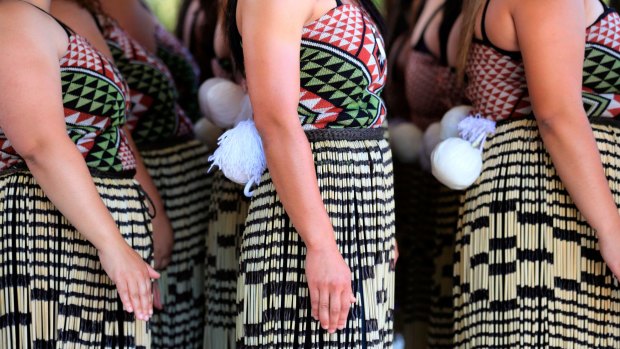
The population, like Australia, is a melting pot. There are Pakeha, New Zealanders of European descent; Maori, the indigenous Polynesian people who arrived in canoes in the 14th Century; Pacific Islanders who migrated from Samoa, Tonga, the Cook Islands and French Polynesia in the 20th Century; and Asians, including a large Indian community.
There are three official languages: English; te reo Māori; and sign language. In Māori, "w"' is pronounced as "f" and "au" as "oh". The most useful (and common) Maori phrase to know is "kia ora" which is a way to greet people, a sign of thanks and goodbye. If you want to connect with the Aotearoa's rich and proud Maori culture, as indeed you must, the North Island, where Indigenous New Zealanders are concentrated, is where you should be. The South Island tends to be populated more by Pakeha and other racial groups.
Rotorua (rotoruanz.com), under three hours' driving time south-east of Auckland, is the beating heart of Maori culture with living villages that give visitors an insight into traditional culture and customs and offer marae stays, where you can enjoy a hāngi dinner with the food baked in an underground pit, and dance performances.
The less touristy Northland region, including the Bay of Islands, is the best part of New Zealand to learn about Maori culture and the sometimes ferocious clashes with the British in the 19th century. Further south, and still on the North Island, in the capital Wellington, there's the acclaimed Museum of New Zealand Te Papa Tongarewa (tepapa.govt.nz). It showcases all things Pacific, where you can look at fascinating exhibits, watch films, listen to storytellers and join in a Maori dance demonstration.
TRAVELLER CHEAT SHEET
Never confuse a hāngi with a hongi, the traditional form of Maori greeting, involving two people pressing their noses and foreheads against each other to "share the breath of life". COVID-19, however, may mean you're less likely to see this.
LESSON FIVE: THE STAYS
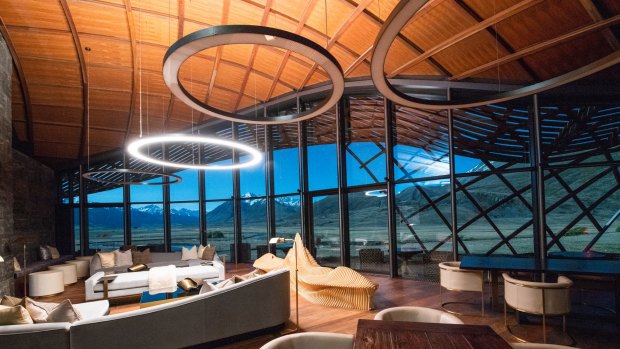
Japan has it ryokans, India its maharaja palaces, Spain has its paradores and New Zealand has its luxury lodges (luxurylodgesofnz.co.nz; newzealand.com). Although reliant on affluent European and North American travellers (and less so Australians), these lodges in some of the most beautiful spots in the country are still going strong, with the pick including Eagles Nest (eaglesnest.co.nz) at the Bay of Islands and Kinloch Manor (kinlochmanor.co.nz) at Lake Taupo on the North Island. On the South Island, there's the new The Lindis (thelindisgroup.com) in Ahuriri Valley and the Split Apple Retreat (splitapple.com) on the edge of the Abel Tasman National Park.
There have also been a flurry of new hotel openings during the pandemic. In Auckland, these include luxury boutique-style digs such The Hotel Britomart (thehotelbritomart.com) and the exclusive and expensive Park Hyatt Auckland. For a taste of the city's hip inner-city lifestyle, consider Hotel Fitzroy (fablehotelsandresorts.com), and The Convent (theconvent.co.nz), both in fashionable Grey Lynn.
In Christchurch, there's the new boutique Cosa Hotel (cosahotel.co.nz) while in Dunedin the Ebb Dunedin, (ebb-dunedin.co.nz) a contemporary hotel with a design inspired by the city's history and coastline is a newcomer. Near sunny Nelson, in the north of the South Island, is Falcon Brae Villa (stoneflylodge.co.nz) on a hilltop with 360-degree views over the mountains and Motueka River.
TRAVELLER CHEAT SHEET
For the ultimate New Zealand splurge, book a stay at the new premier four-suite villa Mount Isthmus (thelindisgroup.com), on a 2000-hectare station just outside Wanaka, with its own private chef, fly fishing, hiking and kayaking, surrounded by rugged mountains and fabulous views.
THE MUST-KNOWS BEFORE YOU GO
WHAT DO I NEED TO DO BEFORE I BOOK AND GO?
Ensure you've been in Australia for the past 14 days in order to qualify for quarantine-free travel. You also must not have had a positive COVID-19 test in that time, nor be awaiting the results of one. You don't need a negative pre-departure COVID-19 test but you will have to complete an online travel declaration when you book your flights about your plans and provide contact details. Subscribe to the Australian government's Smartraveller website (smartraveller.gov.au) to check for any changes to travel advice and keep an eye on the NZ Ministry of Health website (health.govt.nz).
WHAT ARE THE PASSPORT REQUIREMENTS?
Australian or New Zealand citizens don't need visas, but if you're not either, you must hold a valid visa or electronic travel authority (NZeTA).
WILL I NEED INSURANCE?
Australia and New Zealand have a reciprocal health care agreement which allows Australians to access public medical facilities and care. But there are things it doesn't cover and it'd be wise to buy comprehensive travel insurance, particularly one that covers COVID-19, such as Cover-More (covermore.com.au), in the unlikely case you contract the virus or there is an outbreak and you have to pay for quarantine and cancel your plans.
WHAT CAN I EXPECT AT THE AIRPORT AND ON THE PLANE, BOTH WAYS?
At departure and arrival you'll be asked questions about your health and you won't be allowed to travel at all if you have cold or flu symptoms. You'll be guided through a green quarantine-free zone of the airport, well away from the quarantine-compulsory red zone. You'll also have to wear a mask while on the plane and also on any domestic flights and public transport within New Zealand. When booking your flights it'd be wise to buy changeable tickets in the event you can't travel or are caught in a lockdown. As the New Zealand Prime Minister, Jacinda Ardern, recently warned in respect to the trans-Tasman bubble, "flyer beware".
WHAT WILL I NEED TO DO ON ARRIVAL?
You'll have to download the New Zealand COVID Tracer app (there'll be a QR code at the airport for it) for checking into all businesses and services, and contact-tracing. There are also free booklets for you to take note of everywhere you've been.
WHAT HAPPENS IF THERE'S A SUDDEN LOCKDOWN?
Sorry, but you'll just have to sit tight if you're visiting a hot spot, like all of the Kiwis around you. However, there's a chance that any lockdown may be confined to a particular region or city, such as Auckland, where the main quarantine "medi-hotels" are located. Be prepared for delays if this happens and be aware that government assistance is unlikely to be available. You may then face quarantine when you arrive back in Australia.
WILL I BE WELCOME ACROSS THE TASMAN DURING THIS TIME?
Kiwis are proud and protective of their COVID-19 containment success, which, even more than Australia's achievement, is the envy of the world. Be considerate and obey the rules at all times during your visit and do not shut yourself off from the daily news while you're there.
DOS AND DON'TS
DON'T worry about the poisonous animals – there aren't any. The humans are also invariably safe and non-threatening.
DO pack for every season. New Zealand is known for having four of them in one hour and the trans-Tasman bubble is kicking off just as the weather starts to cool across the country.
DON'T bring food into the country. There are strict biosecurity measures in place to protect the environment.
DO take the Tiaki Promise – the pledge to keep New Zealand clean and green. Take your rubbish with you and stick to the tracks when tramping.
DON'T feel obliged to tip. A warm "thank-you" for good service will suffice though a gratuity will be appreciated in a tourism-dependent nation that's done it tough in the pandemic.
DO be careful lavishly praising Jacinda Ardern wherever you go. A lot of Kiwis voted for her but a fair few didn't.
DON'T take a Kiwi's "yeah" as necessarily a "yes". Some may respond, "yeah, nah", which is a nice way of saying "no".
DO remember that it's Jacinda Ardern, not Jacinta Adern or, heaven forbid, Jacinta Ahern (and be careful, too, with Clarke Gayford, the name of the first bloke).
Sign up for the Traveller Deals newsletter
Get exclusive travel deals delivered straight to your inbox. Sign up now.